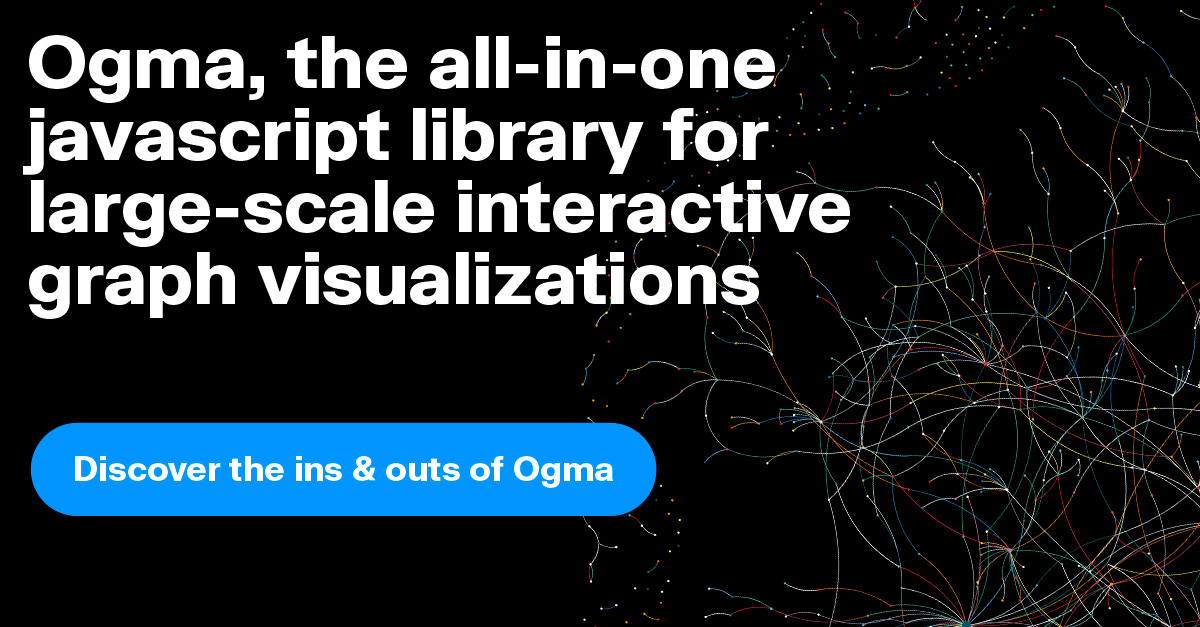Network Analysis: Building meaningful visual narratives with JavaScript data visualization libraries
Data, whether coming from internal or external sources, has the potential to inundate organizations, but it also holds the key to unlocking a wealth of information–if you can effectively tap into it, that is.
Over the last decade, graph data (data organized as a network of nodes and relationships) has become indispensable for data professionals and analysts to perform advanced network analysis and derive key insights from complex connected data. Enter the realm of data-driven storytelling for network analysis with JavaScript data visualization libraries, where the fusion of raw data and compelling insights takes center stage.
JavaScript data visualization libraries serve as a toolkit to better understanding and analyzing your connected data. It allows developers to add interactive graph visualization capabilities to existing applications. Network analysis works by piecing together data and its relationships within graph visualizations, leading to more context and insights to what stories may lie within.
In this post, we’ll explore how JavaScript data visualization libraries can elevate network analysis to new heights, turning data into a compelling story waiting to be told.
JavaScript data visualization libraries are ideal for developers looking to add powerful graph capabilities to their applications, resulting in interactive and dynamic graph visualizations. Not only do they empower users with the ability to easily visualize and navigate through intricate network structures and uncover stories woven throughout, but they can be fully customized to an organization's unique needs.
In addition, JavaScript data visualization libraries can be seamlessly integrated with existing applications and provide advanced visualization capabilities at scale–all while cutting down on development time.
These JavaScript data visualization libraries are instrumental in deriving valuable business insights from your connected data.
Revealing hidden stories
JavaScript libraries boast key capabilities such as filtering visualizations, displaying time-sensitive or geographical data, or adapting the visual language of a visualization, and more.
These capabilities make them particularly effective at creating visualizations that uncover hidden patterns or insights that may otherwise have gone unnoticed. Through intuitive graph visualizations, users are able to easily identify relationships within complex networks and pinpoint potential antagonists.
Allowing for user-driven exploration
JavaScript data visualization libraries allow you to create rich and interactive experiences–making data exploration more accessible and comprehensible, no matter a user's level of technical expertise. It ensures that narratives unfold organically by allowing the exploration of various paths within your data.
Conducting dynamic analysis
As data continues to evolve, stories can shape-shift, adding new chapters to the narrative. With robust features of JavaScript data visualization libraries, users have the ability to adjust the level of information within a network. Whether drilling down into specific relationships or taking a birds eye view of your graph visualizations, the ability to explore data through different lenses is a catalyst for improved decision making.
JavaScript data visualization libraries designed for network analysis can help organizations build compelling narratives across various domains. From fraud detection to supply chain management and software infrastructures, these JavaScript libraries pave the way for transformative insights and more informed decision making.
Fraud Detection
Visualizing and understanding the connections between entities, be it people, places, transactions, and more, is crucial for fraud detection. Without a complete picture of these connections, seemingly innocuous behavior patterns could reveal themselves as part of a larger, illicit scheme. Organizations turn to JavaScript data visualization libraries in fraud detection to visualize their data as a network, making it possible to uncover patterns and add context to their investigations.
Supply Chain Management
JavaScript data visualization libraries are invaluable to organizations needing a holistic view of their supply chain. By presenting supply chains as a graph visualization, users can better track goods and optimize logistics. They provide the transparency and traceability needed to better anticipate risks, spot bottlenecks, and ensure the smooth flow of goods throughout the supply chain.
Software Infrastructures
Mapping today’s modern software systems can be a daunting task, with the need to understand several layers of dependencies and interactions within systems. Developers and IT professionals can use visualizations created through JavaScript libraries to map these intricacies, allowing them to better identify potential performance issues, perform impact analyses, and optimize their software architectures for increased reliability and scalability.
In the dynamic realm of data-driven narratives, JavaScript data visualization libraries emerge as a powerful tool for developers to transform raw graph data into interactive visualizations that can facilitate the analysis of complex networks to derive compelling stories. From uncovering hidden patterns and enabling user-driven exploration to conducting dynamic analyses and more, these JavaScript data visualization libraries redefine how we perceive and interact with intricate networks.
But not all JavaScript data visualization libraries are created equal. Visualizing larger datasets requires a robust library with advanced capabilities that allow you to adapt and scale to your needs.
Commercial JavaScript libraries such as Ogma are designed for large-scale interactive graph visualizations and come equipped with all the features and technical support needed to fit the bill. You can learn more about Ogma here and request a customized demo or free trial. And, if you’re looking to build compelling narratives for your users through the addition of graph capabilities, check out our starter guide for developers on JavaScript data visualization libraries.
A spotlight on graph technology directly in your inbox.
